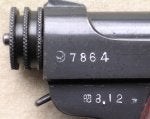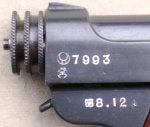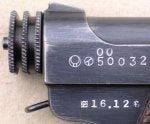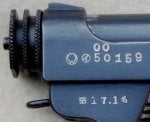My primary Japanese militaria collecting focus is pistols – especially the Type 14 Nambu. That focus took shape in the mid-1970s when my father and I realized we could not collect every Japanese military item we ran across. Starting in the mid-1960s, we had accumulated a lot of stuff; it was just too much in terms of space, money, and, especially, peace in the family (my mother finally had enough of our stuff crammed all over the house). So, we decided to specialize and concentrate our collection on the Japanese pistols that we could afford with the Type 14 being at the top of that short list.
The contributors to this board are primarily rifle collectors. That is good, as I have learned a lot from the many informational posts about rifles (and also about many other collectible Japanese military items). We retained a dozen or so representative rifle type examples and some other militaria items from our early collecting days, and it is nice to see one of them discussed now and then. It is especially interesting to see posts about seldom-seen/rare rifles and other militaria items. The knowledge I have gained from those posts has been very helpful; I think I could recognize some of the rare stuff if ever found. But, unfortunately for me, posts about Japanese pistols seem to be few and far between; I’d like to see more.
Not long ago, I authored a general information article about Type 14 Nambu dated production and major variation totals in BANZAI (see the June 2024 issue). In it, year-dated factory production amounts were charted to give a sense of what Type 14s were common and what specific pistols were harder to find. The seven rarest and most valuable Type 14 Nambu production date code variations encountered were discussed and recognition images were shown. I believe information about those Type 14 production rarities would be of interest to members of this forum.
The seven rarest production marking variations are “Taisho,” “Nagoya Only,” two versions of the “Vertical Arsenal,” two versions of the “Double Zero,” and the “Last Ditch 20.8.” A chart giving some production and survival specifics and brief descriptions with recognition images of those seven variations are given below. Hopefully, with this recognition information, some additional examples will surface. If any collector finds or has one of these seven rare pistols, please contact me to supply information for my database.
TAISHO – Chigusa Arsenal dated 15.8 (1926.Aug) through 15.12 (1926.Dec): Emperor Taisho passed in late Dec. 1926 not long after Type 14 production began. The dating system changed with the accession of Emperor Hirohito. This is the most sought-after Type 14 marking variation.
![]()
NAGOYA ONLY – Kokubunji Factory date 8.12 (1933.Dec): At factory start-up, Kokubunji continued the pistol serialization sequence from the Chigusa Arsenal and retained the single Chigusa “Nagoya” factory mark for a short period.
![]()
VERTICAL ARSENAL – Kokubunji Factory dated 8.12 (1933.Dec) through 9.2 (1934.Feb): The second factory symbol for “Nambu” is added vertically below the “Nagoya” symbol. Later in 9.2, the two marks were positioned horizontally. Collectors consider these to be two variations for the two date years.
![]()
![]()
DOUBLE ZERO – Toriimatsu Factory dated 16.10 (1941.Oct) through 17.1 (1942.Jan): At factory start-up with #50000, Toriimatsu changed the design of several internal parts. These parts will not interchange with other factory parts and with later Toriimatsu production pistols. The part design “experiment” was changed back to normal-design parts around #50185. Later, two zeros were positioned over the first two serial numbers to identify these pistols as being different from normal production. These pistols were likely put in storage and not distributed which may explain their high survival rate. Collectors consider these to be two variations for the two date years.
![]()
![]()
LAST DITCH 20.8 – Toriimatsu Factory date 20.8 (1945.Aug): Unlike the other rare variations, these examples are not marked differently from normal production. The date is notable and very much in demand because of it being the last month of the war.
![]()
The contributors to this board are primarily rifle collectors. That is good, as I have learned a lot from the many informational posts about rifles (and also about many other collectible Japanese military items). We retained a dozen or so representative rifle type examples and some other militaria items from our early collecting days, and it is nice to see one of them discussed now and then. It is especially interesting to see posts about seldom-seen/rare rifles and other militaria items. The knowledge I have gained from those posts has been very helpful; I think I could recognize some of the rare stuff if ever found. But, unfortunately for me, posts about Japanese pistols seem to be few and far between; I’d like to see more.
Not long ago, I authored a general information article about Type 14 Nambu dated production and major variation totals in BANZAI (see the June 2024 issue). In it, year-dated factory production amounts were charted to give a sense of what Type 14s were common and what specific pistols were harder to find. The seven rarest and most valuable Type 14 Nambu production date code variations encountered were discussed and recognition images were shown. I believe information about those Type 14 production rarities would be of interest to members of this forum.
The seven rarest production marking variations are “Taisho,” “Nagoya Only,” two versions of the “Vertical Arsenal,” two versions of the “Double Zero,” and the “Last Ditch 20.8.” A chart giving some production and survival specifics and brief descriptions with recognition images of those seven variations are given below. Hopefully, with this recognition information, some additional examples will surface. If any collector finds or has one of these seven rare pistols, please contact me to supply information for my database.
Variation | Arsenal/Date | Known Serial Number Range | Known Examples | Approx. Possible Production | Approx. % of Total Production | “X” Out of 10,000 Examples |
| Nagoya Only | Kokubunji 8.12 | 7835 – 7908 | 6 | 75 | 0.03 = | = 3 |
| OO 16 | Toriimatsu 16.10 to 16.12 | 50001 – 50080 | 28 | 80 | 0.03 = | = 3 |
| OO 17 | Toriimatsu 17.1 | 50082 – 50185 | 22 | 105 | 0.04 = | = 4 |
| Taisho | Chigusa 15.8 to 15.12 | 6 – 104 | 17 | 110 | 0.04 = | = 4 |
| Vertical 8 | Kokubunji 8.12 | 7910 – 8017 | 6 | 125 | 0.05 = | = 5 |
| Last Ditch 20.8 | Toriimatsu 20.8 | 72810 – 72991 | 6 | 200 | 0.07 = | = 7 |
| Vertical 9 | Kokubunji 9.1 & 9.2 | 8035 – 8479 | 23 | 500 | 0.18 = | = 18 |
TAISHO – Chigusa Arsenal dated 15.8 (1926.Aug) through 15.12 (1926.Dec): Emperor Taisho passed in late Dec. 1926 not long after Type 14 production began. The dating system changed with the accession of Emperor Hirohito. This is the most sought-after Type 14 marking variation.

NAGOYA ONLY – Kokubunji Factory date 8.12 (1933.Dec): At factory start-up, Kokubunji continued the pistol serialization sequence from the Chigusa Arsenal and retained the single Chigusa “Nagoya” factory mark for a short period.

VERTICAL ARSENAL – Kokubunji Factory dated 8.12 (1933.Dec) through 9.2 (1934.Feb): The second factory symbol for “Nambu” is added vertically below the “Nagoya” symbol. Later in 9.2, the two marks were positioned horizontally. Collectors consider these to be two variations for the two date years.


DOUBLE ZERO – Toriimatsu Factory dated 16.10 (1941.Oct) through 17.1 (1942.Jan): At factory start-up with #50000, Toriimatsu changed the design of several internal parts. These parts will not interchange with other factory parts and with later Toriimatsu production pistols. The part design “experiment” was changed back to normal-design parts around #50185. Later, two zeros were positioned over the first two serial numbers to identify these pistols as being different from normal production. These pistols were likely put in storage and not distributed which may explain their high survival rate. Collectors consider these to be two variations for the two date years.


LAST DITCH 20.8 – Toriimatsu Factory date 20.8 (1945.Aug): Unlike the other rare variations, these examples are not marked differently from normal production. The date is notable and very much in demand because of it being the last month of the war.










